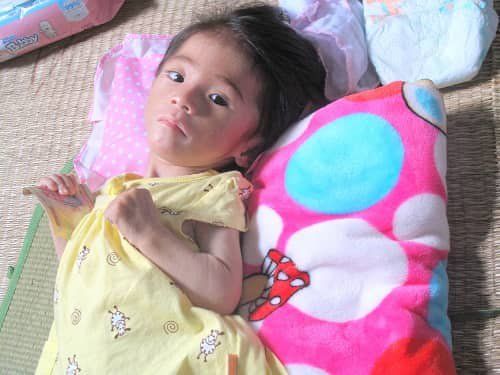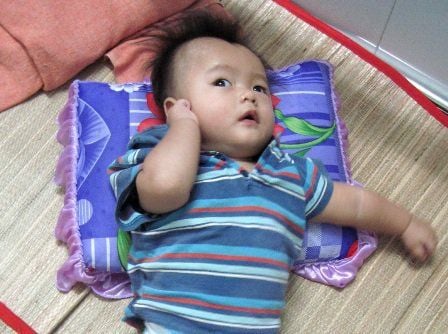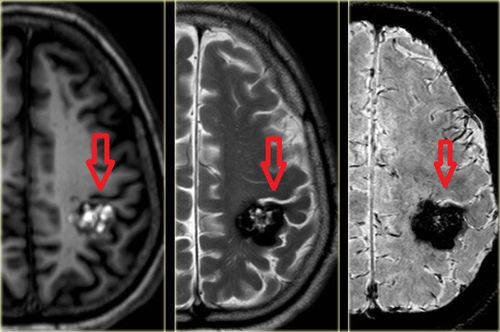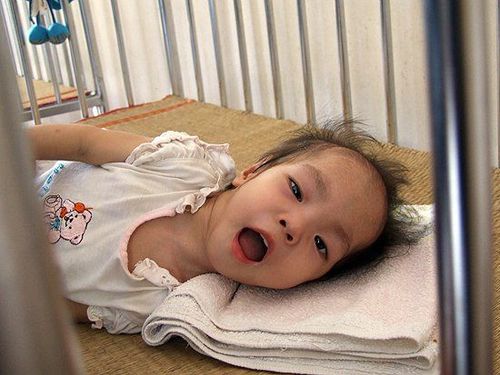This is an automatically translated article.
Cerebral palsy is a disease that seriously affects the health and future of children. Children with cerebral palsy have warning signs in advance, parents need to take careful care and pay attention to their children's activities to promptly detect and treat symptoms of the disease.1. Overview of cerebral palsy
Cerebral palsy is a syndrome that affects movement, muscle tone, or posture. It is caused by damage to the developing brain (immature brain), seen in the fetus before birth.Signs of cerebral palsy appear early, in infancy or preschool age. Typically, cerebral palsy reduces mobility associated with abnormal reflexes, limbs becoming flaccid or spastic, abnormal posture, difficulty with movement, unsteadiness of walking, or a combination of symptoms. evidence above.
People with cerebral palsy may have problems swallowing, eye muscle imbalance in which the eye is not able to focus on an object. The disease can also reduce the range of motion of the joints due to muscle spasticity.
Manifestations of cerebral palsy vary from body to body. Some people are able to walk normally, while others need help. Some people have normal or relatively normal intellectual development, while others have an intellectual disability. In addition, people with cerebral palsy are also at risk of epilepsy, blindness and deafness.

Biểu hiện của bệnh bại não trên mỗi cơ thể là khác nhau
2. Early warning signs of cerebral palsy
In 3 to 6 month old baby The head falls back when you pick the baby up from the supine position Stiff limbs Body flabby Body Overstretched back and neck when holding the baby in the arms Stiff legs, crossed legs like scissors when holding growing up In children older than 6 months Does not roll in both directions Unable to clasp hands Difficulty bringing hands to mouth Reaching out with only one hand while holding the other In children older than 10 months Crawling slowly, push off with one arm and leg while pulling the opposite arm and leg Butt and knee function normally but do not crawl on all fours In general, the signs and symptoms of cerebral palsy are related to motor problems. Movement and coordination include:Abnormal muscle tone, such as too stiff or too soft Muscle spasticity and excessive reflexes Muscle spasticity with normal reflexes Lack of balance and muscle coordination (loss conditioning) Movement and abnormal vibrations Slow, difficult movements Slow movement for age, such as pushing up, sitting or crawling One side of the body more such as one-handed movement or one-leg pulling during crawling Difficulty walking, such as toe walking, stooping gait, pulling gait with crossed knees, wide or unbalanced gait Excessive drooling or problems swallowing Difficulty sucking or eating Slow voice or speech development Difficulty learning Difficulty with motor skills such as buttoning clothes or picking up things Seizures

Động kinh là một trong những triệu chứng của bệnh đông kinh liên quan đến vận động và phối hợp
Difficulty hearing Intellectual disability Seizure abnormalities Touch, especially pain, Oral disease Disorders psychiatry Urinary incontinence Cerebral palsy can affect the entire body, or be limited to a limb or side of the body. The brain disorder causes permanent cerebral palsy, so symptoms usually don't get worse with age. However, as the child gets older, some symptoms may become more or less obvious. Muscle spasticity can worsen if not treated aggressively.
3. Things to know about cerebral palsy
Cerebral palsy (CP) is a group of disorders that affect a person's ability to move, maintain balance, and posture. Cerebral palsy is the most common motor disability of childhood. About 1 in 345 children have been identified with cerebral palsy, according to estimates from the Autism and Disability Monitor (ADDM) and the US Centers for Disease Control and Prevention. Cerebral palsy occurs more frequently in boys than in girls and is more common in black children than in white children. Most (about 75%-85%) children with cerebral palsy have spastic cerebral palsy. This means that the muscles are stiff, making movement difficult. More than half (approximately 50%-60%) of children with cerebral palsy are able to walk independently. Many children with cerebral palsy have multiple comorbidities, known as co-occurring conditions. For example, about 4 out of 10 children with cerebral palsy also have epilepsy and about 1 in 10 have an autism spectrum disorder. Most cerebral palsy is related to brain damage that occurs before or during birth and it is called congenital cerebral palsy. The following factors may increase the risk of congenital cerebral palsy : Being born too small Giving birth too soon Twins or having multiple babies Conceiving using in vitro fertilization or other assisted reproductive technology Mother infection during pregnancy. Get kernicterus (a type of brain damage that can happen when severe neonatal jaundice is left untreated) Birth complications A small percentage of cerebral palsy is caused by brain damage that occurs more than 28 days after birth. The following factors may increase the risk for acquired cerebral palsy: Having a brain infection, such as meningitis Having a severe head injury The specific cause of cerebral palsy in most children is unknown. Cerebral palsy is usually diagnosed during the first or second year after birth. If the symptoms are mild, it can sometimes be difficult to diagnose until the child is a few years old. With the right services and supports, children and adults with cerebral palsy can live well, function and integrate into the community.
Nguyên nhân cụ thể của bại não ở hầu hết trẻ em là không rõ
4. Causes of cerebral palsy
Cerebral palsy is caused by an abnormality or disruption in brain development, most commonly before a baby is born. In many cases, the cause is not known. Factors that can increase the risk of brain problems include:Gene mutations that lead to abnormal brain development Maternal infections affecting the developing fetus Fetal stroke, disruption of the supply of blood supply to the developing brain Brain bleeding in the womb or at birth An infection in a newborn that causes inflammation in or around the brain Head trauma to an infant from a motorcycle accident or a fall Lack of oxygen to the brain involved difficult labor or delivery, although asphyxia associated with vaginal delivery rarely causes cerebral palsy.
5. Risk factors for cerebral palsy
Several factors increase the risk of cerebral palsy.5.1 Maternal health Certain infections or toxic exposures during pregnancy can significantly increase the baby's risk of cerebral palsy. Infections of particular concern include:
Cytomegalovirus: This common virus causes flu-like symptoms and can lead to birth defects if the mother is infected early in pregnancy. Rubella: This viral infection can be prevented with a vaccine. Genital herpes: The disease can be passed from mother to baby during pregnancy, affecting the uterus and placenta. Inflammation caused by an infection can damage the developing nervous system of the unborn baby. Syphilis: This is a sexually transmitted bacterial infection. Toxoplasmosis: This infection is caused by parasites found in contaminated food, soil, and feces of infected cats. Zika virus infection: Newborns infected with Zika by their mothers that make their heads smaller than normal (microcephaly) can develop cerebral palsy. Other risks: Other risks include thyroid problems, intellectual disability or seizures, and exposure to toxins like mercury, methyl. 5.2 Sick newborns Illnesses in infants that can significantly increase the risk of cerebral palsy include:
Bacterial meningitis : This bacterial infection causes inflammation in the membranes surrounding the brain and spinal cord. Viral encephalitis: This viral infection similarly causes inflammation in the membranes surrounding the brain and spinal cord. Severe or untreated jaundice: Jaundice occurs when certain byproducts of "used" blood cells are not filtered out of the body. Bleeding in the brain: This condition is usually caused by a baby having a brain stroke in the womb. 5.3 Other pregnancy and delivery factors Pregnancy or childbirth factors that are associated with an increased risk of cerebral palsy include:
Birth in reverse : Children with cerebral palsy are more likely to be in the cross-legged position cervix at the onset of labor instead of the head. Low birth weight: Babies who weigh less than 5.5 pounds (2.5 kg) have a higher risk of developing cerebral palsy. This risk increases with lower body weight. Multiple Births: The risk of cerebral palsy increases with the number of fetuses in utero. If one or more fetuses die, the survivors' risk of cerebral palsy is increased. Premature birth: Babies born less than 28 weeks pregnant have a higher risk of cerebral palsy. The earlier a child is born, the greater the risk of cerebral palsy.

rẻ sinh ra dưới 28 tuần có thai có nguy cơ bại não cao hơn
6. Prevention of cerebral palsy
Most cases of cerebral palsy cannot be prevented, but you can reduce your risk. If you are pregnant or planning to become pregnant, you can take the following steps to stay healthy and minimize pregnancy complications:Make sure you are vaccinated : Get vaccinated against Diseases such as rubella, preferably before pregnancy, can prevent the infection from causing brain damage in the unborn baby. Take care of yourself: The healthier you are during pregnancy, the less likely you are to get an infection that leads to cerebral palsy. Seek early and ongoing prenatal care: Regular checkups during pregnancy are a good way to reduce health risks for you and your unborn baby. Seeing your doctor regularly can help prevent premature birth, low birth weight, and infections. Practice child safety measures: Prevent head injuries by providing your child with a car seat, bicycle helmet, bed safety barrier, and proper supervision. Avoid alcohol, tobacco, and illegal drugs: These have been linked with an increased risk of cerebral palsy. Vinmec Times City International Hospital has applied stem cell methods to successfully treat many cases of cerebral palsy that seemed hopeless. The whole process of stem cell transplantation for cerebral palsy at Vinmec is performed very closely, ensuring safety in accordance with international standards. All surgeries are performed by leading experts and doctors with modern machinery and medical equipment.
In addition, Vinmec has also developed a standard transplant procedure so that it can share experiences with colleagues, creating more opportunities for treatment for children with cerebral palsy across the country.
Please dial HOTLINE for more information or register for an appointment HERE. Download MyVinmec app to make appointments faster and to manage your bookings easily.
References: Mayoclinic.org and Cdc.gov












